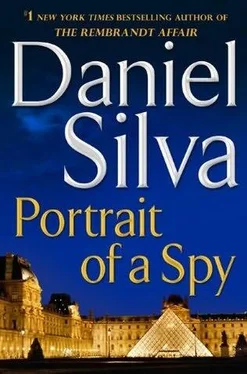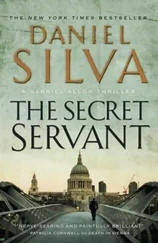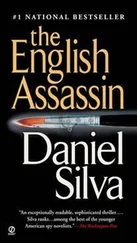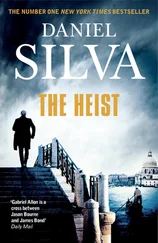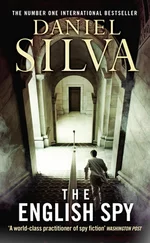Chapter 20
The Palisades, Washington, D.C.
AT THAT SAME MOMENT, a car pulled to the curb in front of a clapboard house located in the Washington neighborhood known as the Palisades. The car, a Ford Focus, was owned by Ellis Coyle of the CIA, as was the clapboard house. A tiny structure, more cottage than home, it had pushed Coyle’s finances to the breaking point. After many years overseas, he had wanted to settle down in one of the affordable suburbs of northern Virginia, but Norah had insisted on living in the District in order to be closer to her practice. Coyle’s wife was a child psychologist, an odd career choice, he always thought, for a woman whose barren womb had yielded no young. Her idyllic commute, a pleasant four-block stroll along MacArthur Boulevard, stood in stark contrast with Coyle’s twice-daily crossing of the Potomac River. For a while, he had tried listening to New Age music to calm his nerves but found it made him only angrier. These days, it was books on tape. He had recently completed Martin Gilbert’s masterpiece on Winston Churchill. In fact, due to repair work on Chain Bridge, it had taken him scarcely a week. Coyle had always admired Churchill’s decisiveness. Lately, Coyle had been decisive, too.
He switched off the engine. He was forced to park on the street because the home for which he had paid close to a million dollars had no garage. He had hoped the cottage would serve as a beachhead in the District, a starter home that he could use to trade up for a larger property in Kent or Spring Valley or perhaps even Wesley Heights. Instead, he had watched in frustration as prices spiraled far beyond the reach of his government salary. Only the wealthiest of Washington’s residents—the bloodsucking lawyers, the corrupt lobbyists, the celebrity journalists who ran down the Agency at every turn—could afford mortgages in those neighborhoods now. Even in the Palisades, the quaint wooden cottages were being torn down and replaced by mansions. Coyle’s neighbor, a successful lawyer named Roger Blankman, had recently built himself an Arts and Crafts monstrosity that cast a long shadow into Coyle’s formerly sunlit breakfast nook. Blankman’s ill-mannered children routinely strayed onto Coyle’s property, as did his army of landscapers, who were constantly making small improvements to the shape of Coyle’s junipers and hedges. Coyle returned the favor by poisoning Blankman’s impatiens. Coyle believed in the efficacy of covert action.
Now he sat motionless behind the wheel, staring at the light burning in his kitchen window. He could imagine the scene that would be played out next, for it changed little from night to night. Norah would be sitting at the kitchen table with her first glass of Merlot, leafing through the mail and listening to some dreadful program on public radio. She would give him a distracted kiss and remind him that Lucy, their black Labrador retriever, needed to be taken out for her nightly constitutional. The dog, like the house in the Palisades, had been Norah’s idea, yet it had somehow become Coyle’s task to oversee its bowel movements. Lucy usually found inspiration in Battery Kemble Park, a hillside of thick woods that was best avoided by unaccompanied women. Sometimes, when Coyle was feeling particularly rebellious, he would leave Lucy’s feces in the park rather than carry it home. Coyle committed other acts of rebellion as well—acts that he kept secret from Norah and his colleagues at Langley.
One of his secrets was Renate. They had met a year earlier in the bar of a Brussels hotel. Coyle had come from Langley to attend a gathering of Western counterterrorism officials; Renate, a photographer, had come from Hamburg to take pictures of a human rights campaigner for her magazine. The two nights they spent together were the most passionate of Ellis Coyle’s life. They saw each other again three months later, when Coyle invented an excuse to travel to Berlin at taxpayer expense, and again a month after that, when Renate came to Washington to shoot a gathering at the World Bank. Their lovemaking reached new levels, as did their affection for one another. Renate, who was single, pleaded with him to leave his wife. Coyle, his face streaming with tears, said he wanted nothing more. He required just one thing. It would take a bit of time, he told her, but it would not be difficult. Coyle had access to secrets—secrets that he could spin into gold. His days at Langley were numbered. So, too, were the nights he would return to Norah and their little cottage in the Palisades.
He stepped out of the car and headed inside. Norah was wearing a dowdy pleated skirt, heavy stockings, and a pair of half-moon glasses that Coyle found singularly unbecoming. He accepted her lifeless kiss and replied, “Yes, of course, dear,” when she reminded him that Lucy needed to be walked. “And don’t be long, Ellis,” she said, frowning at the electric bill. “You know how lonely I get when you’re away.”
Coyle used the techniques taught to him by the Agency to smother his guilt. Stepping outside, he was treated to the sight of Blankman guiding his enormous Mercedes into the second bay of his three-car garage. Lucy growled low in her throat before pulling Coyle in the direction of MacArthur Boulevard. On the opposite side of the wide street was the entrance to the park. A brown wooden sign warned that bicycles were forbidden and that dogs had to remain leashed at all times. At the base of the sign, partially obscured by a clump of weeds, was a chalk mark. Coyle removed Lucy’s leash and watched her bound freely into the park. Then he rubbed out the mark with the toe of his shoe and followed.
A REMARKABLY ACCURATE ACCOUNT OF THE worrisome new terrorist chatter appeared the next morning in the New York Times . Gabriel read the story with more than passing interest on the Amtrak Acela from Washington to New York. His seatmate, a Washington political consultant, spent the entire journey shouting into her mobile phone. Every twenty minutes, a policeman in paramilitary garb strode through the carriage with a bomb-sniffing dog. It seemed the Department of Homeland Security had finally come to realize the trains of Amtrak were rolling terrorist catastrophes waiting to happen.
A prickly rain greeted Gabriel as he emerged from Penn Station. Nevertheless, he spent the next hour hiking the streets of Midtown Manhattan. At the corner of Lexington Avenue and East Sixty-third Street, he saw Chiara peering into the window of a shoe store, a mobile phone pressed to her right ear. Had she been holding it to her left, it would have meant Gabriel was under surveillance. The right meant he was clean and that it was safe to proceed to the target.
He walked across town to Fifth Avenue. Dina was perched on the stone wall bordering Central Park, a black-and-white kaffiyeh around her neck. A few paces farther south, Eli Lavon was buying a soft drink from a street vendor. Gabriel brushed past him without a word and headed toward the used-book stalls at the corner of East Sixtieth Street. An attractive woman stood alone at one of the trestle tables, as though killing a few minutes before an appointment. She kept her gaze downward for several seconds after Gabriel’s arrival, then looked at him for a long moment without speaking. She had dark hair, olive-complected skin, and wide brown eyes. A thin smile animated her face. Not for the first time, Gabriel had the uncomfortable feeling he was being studied by a figure from a painting.
“Was it really necessary for me to take the bloody subway?” Zoe Reed asked resentfully in her posh London accent.
“We had to make certain you weren’t being followed.”
Читать дальше
Конец ознакомительного отрывка
Купить книгу
